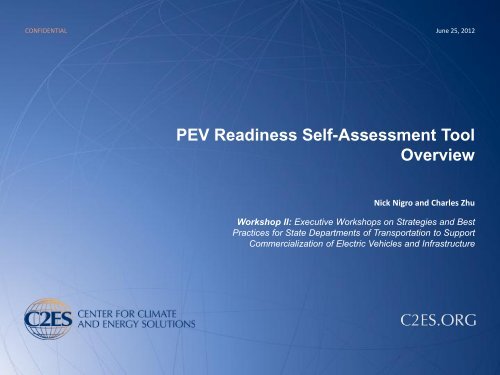PEV Readiness Self-Assessment Tool Overview
PEV Readiness Self-Assessment Tool Overview
PEV Readiness Self-Assessment Tool Overview
You also want an ePaper? Increase the reach of your titles
YUMPU automatically turns print PDFs into web optimized ePapers that Google loves.
CONFIDENTIAL June 25, 2012<br />
<strong>PEV</strong> <strong>Readiness</strong> <strong>Self</strong>-<strong>Assessment</strong> <strong>Tool</strong><br />
<strong>Overview</strong><br />
Nick Nigro and Charles Zhu<br />
Workshop II: Executive Workshops on Strategies and Best<br />
Practices for State Departments of Transportation to Support<br />
Commercialization of Electric Vehicles and Infrastructure
Presentation <strong>Overview</strong><br />
• The challenge for DOTS regarding <strong>PEV</strong>s<br />
• Lots of <strong>PEV</strong>-related activity<br />
• DOTs need to better understand their roles, responsibilities, and<br />
opportunities to take action<br />
• The answer: <strong>PEV</strong> <strong>Readiness</strong> <strong>Self</strong>-<strong>Assessment</strong> <strong>Tool</strong><br />
• Uses framework that incorporates interaction of 3 components of public<br />
sector work: public value, operational capabilities, and legitimacy and<br />
support<br />
• Identifies “archetype” that summarizes the nature of a DOT’s actions and<br />
relationships regarding <strong>PEV</strong>s<br />
• Provides custom feedback based on user-provided input, including<br />
possible actions<br />
<strong>PEV</strong> <strong>Readiness</strong> <strong>Self</strong>-<strong>Assessment</strong> <strong>Tool</strong> <strong>Overview</strong> June 25, 2012
DOT <strong>Self</strong>-<strong>Assessment</strong> <strong>Tool</strong> <strong>Overview</strong><br />
<strong>Self</strong><br />
<strong>Assessment</strong><br />
Modules<br />
Part 1: <strong>Self</strong>-<br />
<strong>Assessment</strong><br />
<strong>Self</strong>-<br />
<strong>Assessment</strong><br />
<strong>Tool</strong> Processing<br />
Part 2: Archetype<br />
Identification & Custom<br />
Information<br />
Archetype<br />
Description including<br />
Possible Actions<br />
Custom Information<br />
including Possible<br />
Actions<br />
<strong>PEV</strong> <strong>Readiness</strong> <strong>Self</strong>-<strong>Assessment</strong> <strong>Tool</strong> <strong>Overview</strong> June 25, 2012
<strong>Self</strong>-<strong>Assessment</strong> <strong>Tool</strong><br />
Architecture<br />
<strong>Assessment</strong><br />
Questions<br />
Custom Information<br />
including Possible Actions<br />
Modules<br />
Factors<br />
Factor<br />
Summary &<br />
<strong>Assessment</strong><br />
Questions<br />
Factor Summary<br />
Questions<br />
Factor Weighting &<br />
Summation Processor<br />
<strong>Assessment</strong><br />
Question<br />
Processor Archetype Assignment<br />
Processor<br />
Archetype Description<br />
including Possible Actions<br />
Input<br />
<strong>Tool</strong><br />
Processor<br />
Output
Public Value Strategic Triangle Framework<br />
• Addresses 2 major issues for public<br />
managers<br />
• Shifting political contexts & priorities<br />
• Need for innovative policies to keep up<br />
with technological & societal change<br />
• Public Value<br />
• <strong>PEV</strong>s’ fit into DOT mission or charter<br />
• Legitimacy & Support<br />
• DOT interaction with outside groups<br />
• Legislative or executive authority<br />
• Operational Capabilities:<br />
• Staff expertise<br />
• Project execution success<br />
Operational<br />
Capabilities<br />
Public Value<br />
<strong>PEV</strong> <strong>Readiness</strong> <strong>Self</strong>-<strong>Assessment</strong> <strong>Tool</strong> <strong>Overview</strong> June 25, 2012<br />
Legitimacy<br />
& Support
<strong>Self</strong>-<strong>Assessment</strong> Module <strong>Overview</strong><br />
Public Value<br />
• Air quality<br />
• Jobs in auto and<br />
related industries<br />
• Energy security,<br />
independence, and<br />
ensuing economic<br />
benefits<br />
• Greenhouse gas<br />
(GHG) emission<br />
reductions<br />
• Being proactive<br />
about the future role<br />
of electrification<br />
Legitimacy and<br />
Support<br />
• Executive and<br />
legislative support<br />
and awareness of<br />
<strong>PEV</strong> benefits<br />
• Consumer and<br />
commercial interest<br />
• Presence of <strong>PEV</strong><br />
collaborative and<br />
interagency groups<br />
• Interest from local<br />
governments and<br />
municipalities<br />
Operational<br />
Capabilities<br />
• DOT-wide support<br />
and champions<br />
• Opportunity for <strong>PEV</strong>related<br />
policies<br />
through existing<br />
policies and historical<br />
precedents<br />
• Empowerment to do<br />
<strong>PEV</strong>-related work<br />
• Networking and<br />
building the case for<br />
external stakeholders<br />
<strong>PEV</strong> <strong>Readiness</strong> <strong>Self</strong>-<strong>Assessment</strong> <strong>Tool</strong> <strong>Overview</strong> June 25, 2012
<strong>Self</strong>-<strong>Assessment</strong> <strong>Tool</strong><br />
Architecture<br />
<strong>Assessment</strong><br />
Questions<br />
Custom Information<br />
including Possible Actions<br />
Modules<br />
Factors<br />
Factor<br />
Summary &<br />
<strong>Assessment</strong><br />
Questions<br />
Factor Summary<br />
Questions<br />
Factor Weighting &<br />
Summation Processor<br />
<strong>Assessment</strong><br />
Question<br />
Processor Archetype Assignment<br />
Processor<br />
Archetype Description<br />
including Possible Actions<br />
Input<br />
<strong>Tool</strong><br />
Processor<br />
Output
<strong>Assessment</strong> Questions<br />
• <strong>Assessment</strong> Questions<br />
• Ask the most detailed questions (e.g. specific actions and policies)<br />
• Form the backbone of the readiness construct<br />
• Example <strong>Assessment</strong> Question under Climate Emissions<br />
Factor in the Public Value Proposition Module<br />
How would you characterize efforts to reduce GHG emissions in<br />
your state?<br />
No interest: No interest in reducing GHG emissions<br />
Limited: Exploring emissions reductions but no proactive<br />
attempts<br />
Medium: Emissions reduction target across various sectors<br />
of the economy, including the transportation sector<br />
Strong: Bill or executive order mandating emissions<br />
reductions, including reductions in transportation<br />
<strong>PEV</strong> <strong>Readiness</strong> <strong>Self</strong>-<strong>Assessment</strong> <strong>Tool</strong> <strong>Overview</strong> June 25, 2012
<strong>Assessment</strong> Questions<br />
• <strong>Assessment</strong> questions lead to direct outputs:<br />
No interest: No interest in<br />
reducing climate emissions<br />
Limited: Exploring emissions<br />
reductions but no proactive<br />
attempts<br />
Medium: Emissions reduction<br />
target across various sectors of<br />
the economy, including the<br />
transportation sector<br />
Strong: Bill or executive order<br />
mandating emissions<br />
reductions, including reductions<br />
in transportation<br />
• You selected “Limited” recognition of<br />
reducing GHG emissions as part of<br />
the <strong>PEV</strong> public value proposition.<br />
• Your DOT can strengthen the public<br />
value proposition of GHG emissions<br />
reductions by conducting and<br />
publicizing a cost-benefit analysis on<br />
GHG emission mitigation in<br />
transportation.<br />
• Your DOT can advise the executive<br />
or provide advice to legislatures<br />
regarding GHG emission reductions.<br />
• Relevant data (e.g. contribution of<br />
transportation to state GHG<br />
emissions)<br />
<strong>PEV</strong> <strong>Readiness</strong> <strong>Self</strong>-<strong>Assessment</strong> <strong>Tool</strong> <strong>Overview</strong> June 25, 2012
<strong>Self</strong>-<strong>Assessment</strong> <strong>Tool</strong><br />
Architecture<br />
<strong>Assessment</strong><br />
Questions<br />
Custom Information<br />
including Possible Actions<br />
Modules<br />
Factors<br />
Factor<br />
Summary &<br />
<strong>Assessment</strong><br />
Questions<br />
Factor Summary<br />
Questions<br />
Factor Weighting &<br />
Summation Processor<br />
<strong>Assessment</strong><br />
Question<br />
Processor Archetype Assignment<br />
Processor<br />
Archetype Description<br />
including Possible Actions<br />
Input<br />
<strong>Tool</strong><br />
Processor<br />
Output
Factor Summary Questions<br />
• Factor Summary Question<br />
• Summarizes all previous assessment questions in a section<br />
• Enables a straightforward way to complete an assessment without<br />
weighing the value of potentially over 50 assessment questions<br />
• Allows for user to account for actions that were not assessed in the factor<br />
by the existing questions<br />
• Example Summary Question<br />
Based on your answers above and on your own knowledge, do <strong>PEV</strong>s<br />
present a strong public value proposition for mitigating GHG emissions?<br />
• None<br />
• Limited<br />
• Medium<br />
• Strong<br />
• Don’t know<br />
<strong>PEV</strong> <strong>Readiness</strong> <strong>Self</strong>-<strong>Assessment</strong> <strong>Tool</strong> <strong>Overview</strong> June 25, 2012
Factor Summary Questions<br />
Public Value<br />
• Air quality<br />
• Jobs in auto and<br />
related industries<br />
• Energy security,<br />
independence, and<br />
ensuing economic<br />
benefits<br />
• Greenhouse gas<br />
(GHG) emission<br />
reductions<br />
• Being proactive<br />
about the future role<br />
of electrification<br />
Limited<br />
Strong<br />
Medium<br />
Limited<br />
Strong<br />
Weighting and<br />
summation<br />
process<br />
<strong>PEV</strong> <strong>Readiness</strong> <strong>Self</strong>-<strong>Assessment</strong> <strong>Tool</strong> <strong>Overview</strong> June 25, 2012<br />
Module<br />
Score
<strong>Self</strong>-<strong>Assessment</strong> <strong>Tool</strong><br />
Architecture<br />
<strong>Assessment</strong><br />
Questions<br />
Custom Information<br />
including Possible Actions<br />
Mod<br />
ules<br />
Fact<br />
ors<br />
Factor<br />
Summa<br />
ry &<br />
Assess<br />
ment<br />
Questio<br />
ns<br />
Factor Summary<br />
Questions<br />
Factor Weighting &<br />
Summation Processor<br />
<strong>Assessment</strong><br />
Question<br />
Processor Archetype Assignment<br />
Processor<br />
Archetype Description<br />
including Possible Actions<br />
<strong>PEV</strong> <strong>Readiness</strong> <strong>Self</strong>-<strong>Assessment</strong> <strong>Tool</strong> <strong>Overview</strong> June 25, 2012<br />
Input<br />
<strong>Tool</strong><br />
Processor<br />
Output
Archetype Assignment<br />
• Two factors for assigning archetypes<br />
• Module summaries<br />
• Specific conditions from assessment questions<br />
• Example archetype criteria<br />
TABLE 1: EXAMPLE CRITERIA FOR DETERMINING ARCHETYPES (LEADER)<br />
Legitimacy and Operational Sample <strong>Assessment</strong> Question Conditions to<br />
Public Value Support Capacity Incorporate<br />
Leader Medium/Strong Strong Strong Must be located in “flexible” office/strong<br />
“empowerment of <strong>PEV</strong>-related work”. Must<br />
be participating in external stakeholder<br />
dialogues.<br />
<strong>PEV</strong> <strong>Readiness</strong> <strong>Self</strong>-<strong>Assessment</strong> <strong>Tool</strong> <strong>Overview</strong> June 25, 2012
Sample Output<br />
• See p. 17 and 18 of self-assessment tool document<br />
• Final self-assessment tool will also contain reference and<br />
look-up tables to look up information about your state<br />
• E.g. hybrid penetration rates, VMT traveled in the state, average prices of<br />
electricity and gas, etc.<br />
<strong>PEV</strong> <strong>Readiness</strong> <strong>Self</strong>-<strong>Assessment</strong> <strong>Tool</strong> <strong>Overview</strong> June 25, 2012
Archetype Descriptions<br />
<strong>PEV</strong> <strong>Readiness</strong> <strong>Self</strong>-<strong>Assessment</strong> <strong>Tool</strong> <strong>Overview</strong> June 25, 2012
Strong public<br />
value proposition<br />
Limited public<br />
value proposition<br />
Weak external<br />
legitimacy and<br />
support for<br />
<strong>PEV</strong>s<br />
Learner<br />
Sideliner<br />
DOT-integrated<br />
<strong>PEV</strong> operations<br />
Convener<br />
Adapter<br />
Actor<br />
Empowered<br />
office for <strong>PEV</strong>s<br />
Little operational<br />
capability for<br />
<strong>PEV</strong>s<br />
Leader<br />
Strong external<br />
legitimacy and<br />
support for<br />
<strong>PEV</strong>s
Next Steps<br />
• Will be built through summer and all of 2012<br />
• Must decide on user interface (e.g. Excel workbook)<br />
• Methodology to be completed:<br />
• Default weighting for various Factor Summary questions within a module<br />
• Finalize archetype definitions and the general “narratives” behind each<br />
archetype<br />
• Complete mapping of <strong>Assessment</strong> Questions to custom output<br />
<strong>PEV</strong> <strong>Readiness</strong> <strong>Self</strong>-<strong>Assessment</strong> <strong>Tool</strong> <strong>Overview</strong> June 25, 2012




